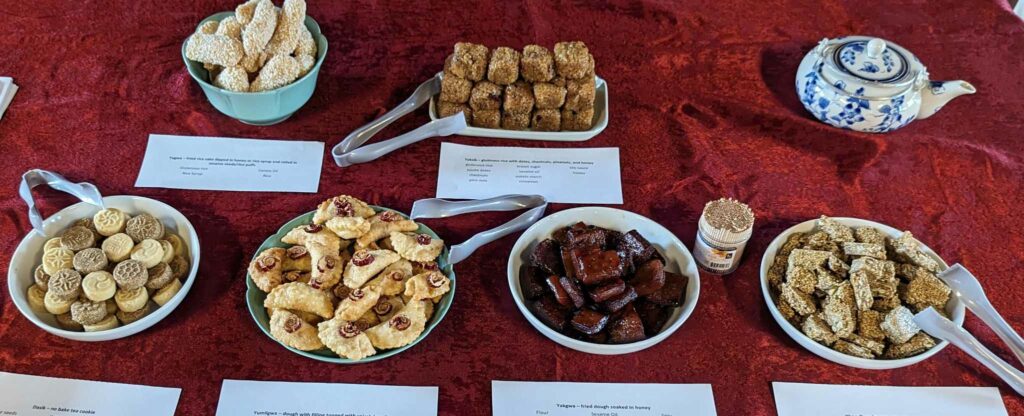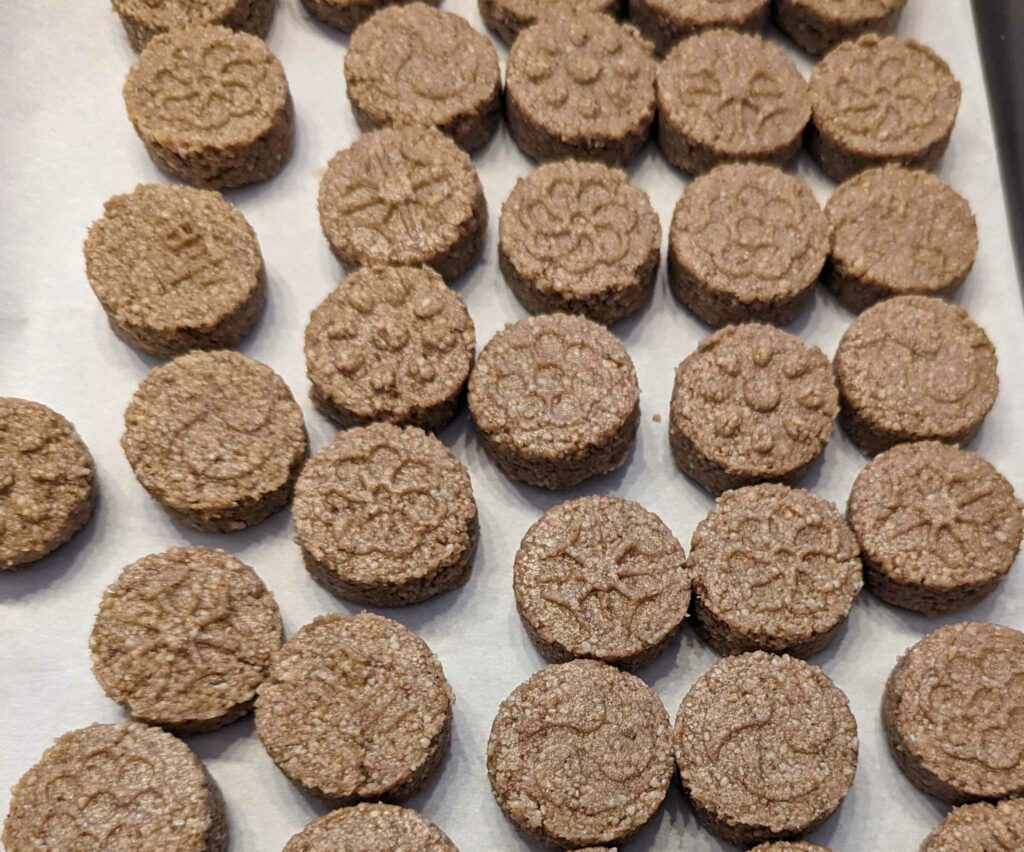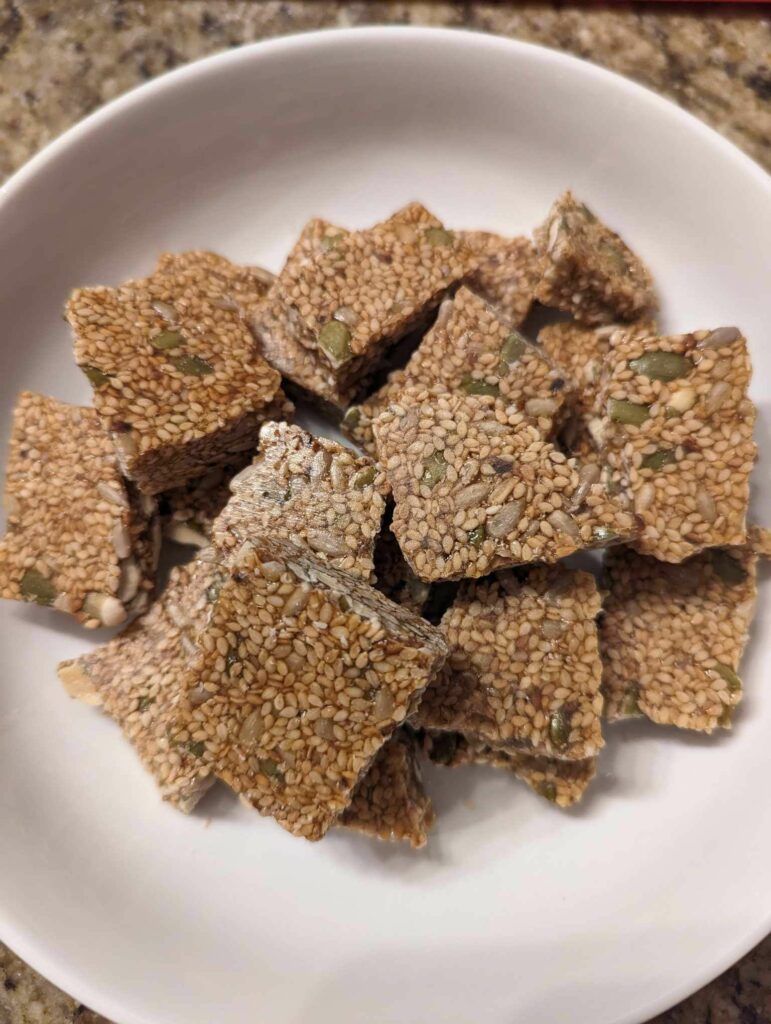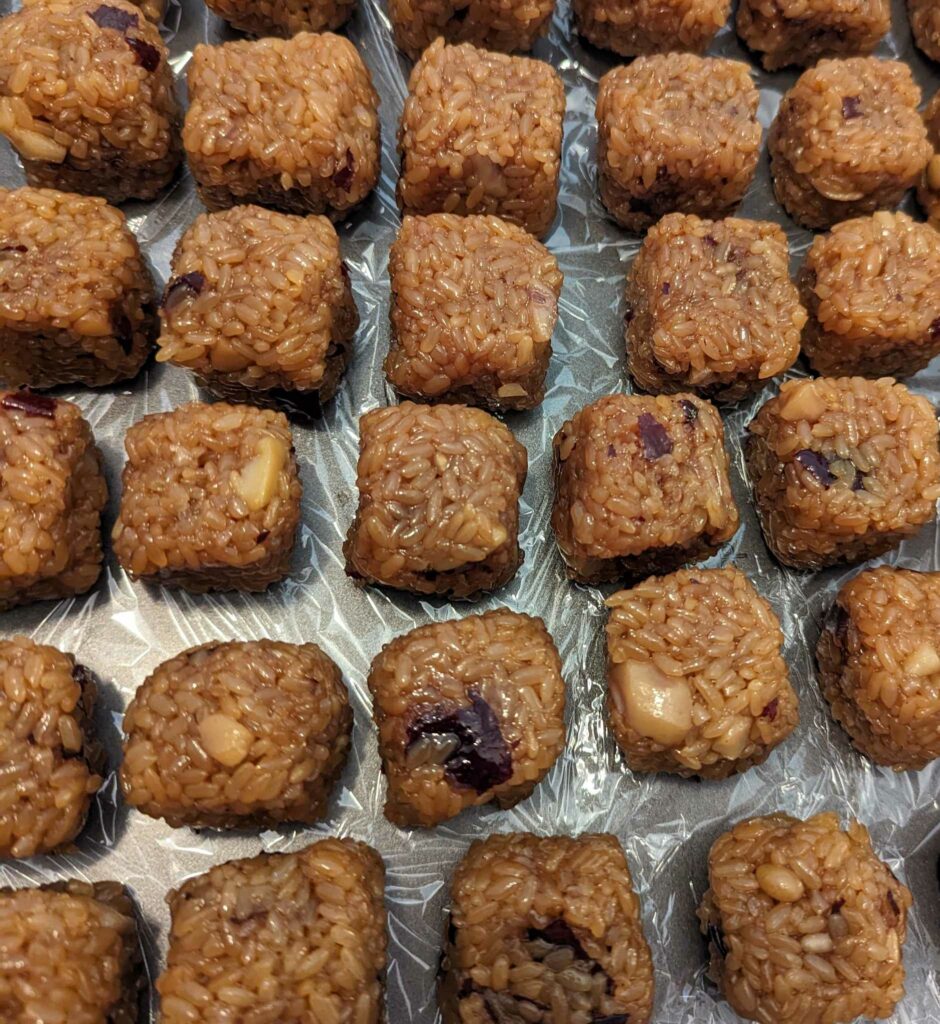다례 한과
Written by Ha Su Jin Daegam (THL)

Hangwa is the term used for traditional Korean cookies or sweets. The origin of hangwa can be traced back to the Silla Dynasty (57BC to 935 AD). During the Goryeo Dynasty (918AD to 1392AD), hangwa started to gain popularity with more desserts being introduced. This increase of popularity was due to the rise of Buddhism which resulted in a ban of meat.
While most desserts can be traced back to an origin, not many can be said to originate from a legend. In the Goryeo times, monk Iryeon published an unofficial history called “Memorabilia of the Three Kingdoms”. In this unofficial history, the legend of yaksik is told.
King Soji (500AD) was going on a picnic when he was approached by a mouse and a crow. To the king’s surprise, the mouse told the king to follow the crow. The king dispatched a servant to follow the crow. The crow led the servant to a lake, from within an old man appeared. The old man handed the servant a note to give to the king with a warning. If the king opens the note, two people will die. If the king does not open the note, only one person will die.
The king was given the note along with the warning. After much deliberation, the king ultimately decided to open the note. The note instructed the king to shoot arrows in the geomungo (string instrument) box. After shooting the arrows into the box, the king opened it to find a concubine and a monk who were conspiring to kill the king. The king told his cooks to create a dessert with something that crows like, including jujubes, chestnuts, rice, and pinenuts, thus yaksik was created.
While not all hangwa have such elaborate backstories, they are none the less delicious. Here are 6 different types of hangwa.
Yakgwa – fried dough soaked in honey
| Dough: ½ cup flour ½ tsp salt 1/3 tsp pepper 3 ½ Tbs sesame oil 6 cups of cooking oil | Honey syrup for dough: 3 Tbs Honey 3 ½ Tbs soju | Jibcheong syrup: 2 ½ cups grain syrup 2/3 cup water Less than ¼ cup sliced ginger |
Mix the flour, salt, pepper, and sesame oil in a bowl and then press the dough through a strainer. In the honey and soju together. Mix the grain syrup, water, and ginger together in a pot and bring to a boil over medium heat. Allow the mixture to boil for 5 minutes and then set aside to cool down. Mix the flour mixture with the honey syrup a little bit at a time to make a dough. The dough should just hold together without being too wet. Do not over mix the dough or the yakgwa will be hard. Roll the dough flat to about half an inch thick, cut it in half, place the halves on top of one another. Do this process 3 times to laminate the dough. Either roll out the dough to a third of an inch thick. Cut into 1 inch square pieces or press the dough into a mold. Poke several holes into the center of the cut or molded dough to ensure that the center cooks.
Heat two pots of oil, one to about 250°F, and the second to 330°F. Place dough into the 250°F oil and cook until the yakgwa floats to the top and the layers open up. Transfer the yakgwa to the other pot on oil and cook until it turns a light brown, turning it over to ensure an even color. Remove the yakgwa and allow the oil to be drained. Soak the yakgwa in the jibcheong syrup for 4 hours, turning over occasionally. It can be stored in the fridge or freezer, just allow the yakgwa to come back to room temperature before serving.
Yugwa – fried rice cake dipped in honey or rice syrup and rolled in sesame seeds/rice puffs
| 2 cups glutenous rice 3 ½ Tbs soy milk 2 Tbs soju | 1 ½ cup honey ¼ cup sugar Sesame seeds Crushed puffed rice |
Wash 2 cups of glutenous rice. Let it soak for 24 hours. Drain well and place in the blender until it is a fine power. Press through a sieve. Add 1 ½ teaspoon of sugar and mix. Add soy milk and soju by pouring small amounts into the rice flour and rubbing the mixture between your hands. Press the mixture through a sieve. Pour water into a steamer. Place a cloth on the steaming rack and place the rice on the cloth. Once the water is steaming, steam the rice flour mixture for 10 minutes on medium heat, turn the heat to medium and heat for another 5 minutes.
Place the cooked rice mixture in a bowl and pound with a mallet for 5 minutes. On a floured surface, add the pounded dough. Roll out the dough into a thin sheet.
Dry it out the dough. This can be done by placing the dough on a tray at a low temperature in an oven, turning it over occasionally. Another method is to place on an electric heating blanket, turning it over occasionally. The traditional method is to place the dough on a floured cloth and leave it to dry in the sun.
Cut the dried dough into 2 to 3 inch wide strips and then cut each strips into ½ inch strips.
Dasik – no bake tea cookie

| 1 cup sesame seeds 1 cup almond flour | ½ cup rice syrup ¾ cup honey ½ cup sugar 2 Tbs water |
Toast sesame seeds in a pan until light brown. Mix frequently while toasting to prevent burning. In a food processor or mortar and pestle, grind the sesame seeds until the oil starts to come out and the ground seeds start to clump together. In a pan over medium heat, add honey and rice syrup. Heat until the mixture can be evenly stirred. Remove from heat and allow to cool.
In a bowl, add the ground sesame seeds. Add 1 tablespoon of the honey mixture and mix well. If it is still not holding together, add 1 teaspoon at a time. Make sure to knead the dough thoroughly. The dough should needs to be sticky enough to hold together, but if it is too wet then it won’t hold its shape. If it is too dry, then the dough will crumble when being taken out of the mold. Repeat this step with almond flour. Rice flour, mung bean starch, pine pollen, and green bean powder can also be used to make dasik.
Prepare the dasik-pan, a traditional wooden cookie mold, by lightly spreading sesame oil around the inside of the mold. Roll a small amount of dough into a ball. Dip the ball slightly into sesame oil and press into the mold. Fill each mold and then press the top of the dasik-pan to extract the cookies. If unavailable, use any small cookie cutter. On parchment paper, spread out some sesame oil. Roll the dough into a ball and press flat until about ½ inch thick. Cut out shapes.
Yumilgwa – dough with filling topped with spiral date flower
| 2 cup flour ½ tsp salt 1 Tbs sugar ½ water | Pumpkin puree Honey Pine nuts Jujube | ¾ cup sugar ¾ cup water |
In a pot, place pumpkin puree and honey. Cook until the mixture thickens. Add pine nuts to the mixture. In a bowl, add flour, salt, sugar, and water to make a dough. Knead for about 20 minutes. Let the dough rest.
Wash the jujube. Cut the ends off of the jujube. Cut the jujube lengthwise. Cut while slowly rolling the jujube to carefully remove the seed while keeping the flesh on the jujube together as one big piece. Press the jujube flat skin side up and then roll it into a little log. With a sharp knife, cut the log into thin slices to create a little jujube flower.
Roll out the dough on a floured surface and cut with a round cookie cutter. Place the filling inside and fold the dough over. Heat oil until it is about 325. Place the dumplings into the oil and fry until golden brown. Drain excess oil. Make a sugar syrup with sugar and water. Heat until golden brown. Dip in dumplings and place onto a wire rack on top of a baking sheet. Add the jujube flower on top
Kkae Gangjeong – sesame seed candy

| ¼ cup honey ¼ cup rice syrup ½ cup sugar | ½ tsp salt 2 cup sesame seeds 1 cup nuts or seeds of choice |
Toast sesame seeds until lightly golden brown, about 5 minutes. Stir often to make sure it doesn’t burn. In bowl, mix together sesame seeds and other nuts. Prepare a baking sheet with parchment paper. In a pan, add honey, sugar, salt, and water over medium heat. Let it cook without stirring until it becomes a deep golden brown, about 4 minutes. Turn off the heat and quickly add the toasted sesame seeds and nuts/seeds.
Add the mixture to a sheet of parchment paper, spreading it out as much as possible. Place another sheet of parchment paper on top and press down with a rolling pin to flatten it to about ¼ inch. Let it cool. When it is warm to the touch, use your hands to break the pieces in bite size pieces. Store in an airtight container.
Yaksik – glutinous rice with dates, chestnuts, pinenuts, and honey

| 2 cups glutenous rice 5 jujube dates 5 chestnuts ½ cup pine nuts | Sweet rice sauce ½ cup brown sugar ½ cup water 1 Tbs sesame oil 1 Tbs starch ½ tsp cinnamon | Rice seasoning 2 Tbs soy sauce ¼ cup dark brown sugar 2 Tbs sweet rice sauce 2 Tbs honey 2 Tbs sesame oil ½ tsp cinnamon |
Wash the glutenous rice and soak for 5 hours. Drain the rice in a strainer to 10 minutes. Wipe the jujube. Remove the flesh from the seed (set the seeds aside for another step) and cut into 6 pieces. Peel the chestnuts and cut into 6 pieces. Remove the tops of the pinenuts.
Pour water into a steamer. Place a cloth on the steaming rack and add rice inside. Once the water is steaming, steam the rice for 40 minutes. Mix well, reduce heat to low and steam for an additional 20 minutes. Add the jujube seeds and water to a pot and simmer for 15 minutes over medium heat. Strain the tea.
To make the sweet rice sauce by adding sugar and 2 tablespoons of water to a pot over medium heat for 3 minutes. Add oil to the pot. Continue cooking, stirring by swirling the pot until it changes color. Add the remaining water and starch and bring to a boil while stirring for 1 minute. In a bowl, add the rice and the rice seasoning ingredients and mix well. Add the jujubes, chestnuts, and pine nuts and mix again. Spread the mixture into a 9×13 pan covered in plastic wrap, pressing the mixture flat. Allow yaksik to cool before cutting into squares.
Pressure cooker method:
Wash rice, strain the rice, but do not soak. Add all of the ingredients to the pressure cooker. Add 1 cup of water and cook on a rice setting. Mix until seasoning is evenly distributed. Cook again on the shortest rice setting.
It can be stored in the fridge or freezer, just allow the yaksik to come back to room temperature before serving.
